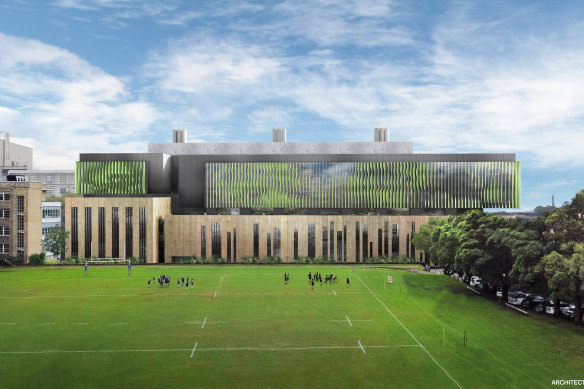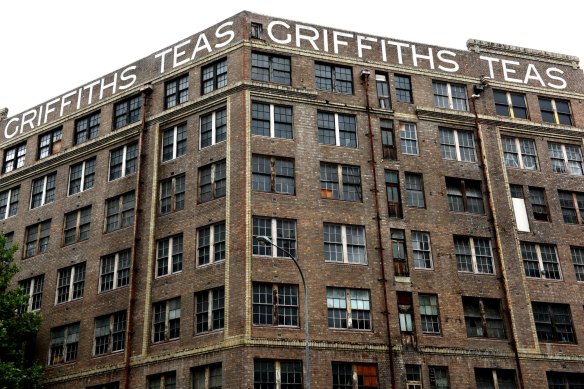By Lucy Carroll
The University of Sydney will pour half a billion dollars into a new medical precinct, a record capital investment bringing 1200 researchers and seven science schools together under one roof.
The biomedical facility, to be built next to Royal Prince Alfred Hospital, will form the “centrepiece” of the university’s 10-year strategic plan, which will be unveiled by vice chancellor Mark Scott on Tuesday.

An artist’s impression of the $478 million biomedical precinct to be built adjacent to Royal Prince Alfred Hospital.
A record $73 million in funding for the facility will come from philanthropic donations. The Susan and Isaac Wakil Foundation is donating $20 million, making it the biggest named donor to the university in its 170-year history.
The Wakils made their fortune in the clothing industry and owned of a slew of buildings across Pyrmont and the central business district until they sold them off in 2014 to fund their foundation.
Their $200 million property portfolio included the inner-city federation-era Griffiths Teas Building that sold for $22 million and later developed into apartments, and a huge century-old converted woolstore at 100 Harris Street that sold for $90 million in 2015.
Susan Wakil, also a prolific arts patron, died four years ago. The couple had no children.
The latest donation will bring the total the family has given to the university to $66 million, which includes $35 million for the Susan Wakil Health Building and another $11 million for nursing scholarships.

University of Sydney chancellor Belinda Hutchinson and donor Isaac Wakil in his home with a model of part of the proposed new building.
Vice chancellor Mark Scott said despite pandemic-induced financial uncertainty, there was “deep engagement with philanthropists for work that is really attacking the big global issues and research of consequence”.
Philanthropic donations have flowed into the university in the past two years, with a record-breaking $145 million given in 2020.
“We are tapping into a level of generosity, with donors looking for ways to have a profound impact. They want to drive ambitious research and help take on the great global challenges,” Scott said.
Chancellor Belinda Hutchinson said the Wakils were “extraordinary philanthropists that have now gifted [the university] more than $66 million, which is the largest named donation to a single institution in NSW history”.

The Griffiths Teas building in Surry Hills was one of many properties sold by the Wakils to fund their charitable foundation.
The new health and research facility, known as the Sydney biomedical accelerator, will spread across three buildings on 36,000 square metres next to RPA and the university’s Camperdown campus.
Scott said the venture will link “scientific and clinical minds with entrepreneurs, industry and government” to tackle complex health challenges, including cancer and neurodegenerative diseases using nanotechnology and gene and stem cell therapy. About $143 million in separate funding for the facility was announced by the state government in June.
“The diseases we will be attacking need a genuine multidisciplinary response, and that’s what a great comprehensive university can do,” Scott said, adding the facility would be benchmarked against international medical institutes including Sweden’s Karolinska Institutet and University of Toronto’s MaRS Discovery District.
“We are attacking the diseases that still remain incurable, and where researchers have toiled for decades and not had the breakthroughs they’ve sought,” he said.
About 1200 biomedical researchers and clinician scientists will work in the building that will bring together seven schools including pharmacy, chemistry and medical sciences.
Another $26 million has been donated to the project from late general practitioner Marie Knispel.
Scott said the “transformation in the philanthropic landscape over the past decade has been remarkable, largely led by the University of Sydney and the University of Melbourne.”
“Increasingly universities are looking for partners to help change the world through research and that’s where you are finding philanthropic partnership takes place. It is very different to donating a hall.”
Architecture firms Denton Corker Marshall and HDR will design the new building, which will open in 2026.
Richard Payne, a professor of organic chemistry who specialises in heart disease and anti-inflammatory drugs at the University of Sydney, said the biomedical site would pull together science and engineering researchers that currently sit in separate schools.
“The only way to tackle global health challenges is to bring disciplines together. Universities have not connected well with local industry in the past and having researchers on one site will help medical discoveries be translated to the clinic and to the patient,” Payne said.
The Morning Edition newsletter is our guide to the day’s most important and interesting stories, analysis and insights. Sign up here.